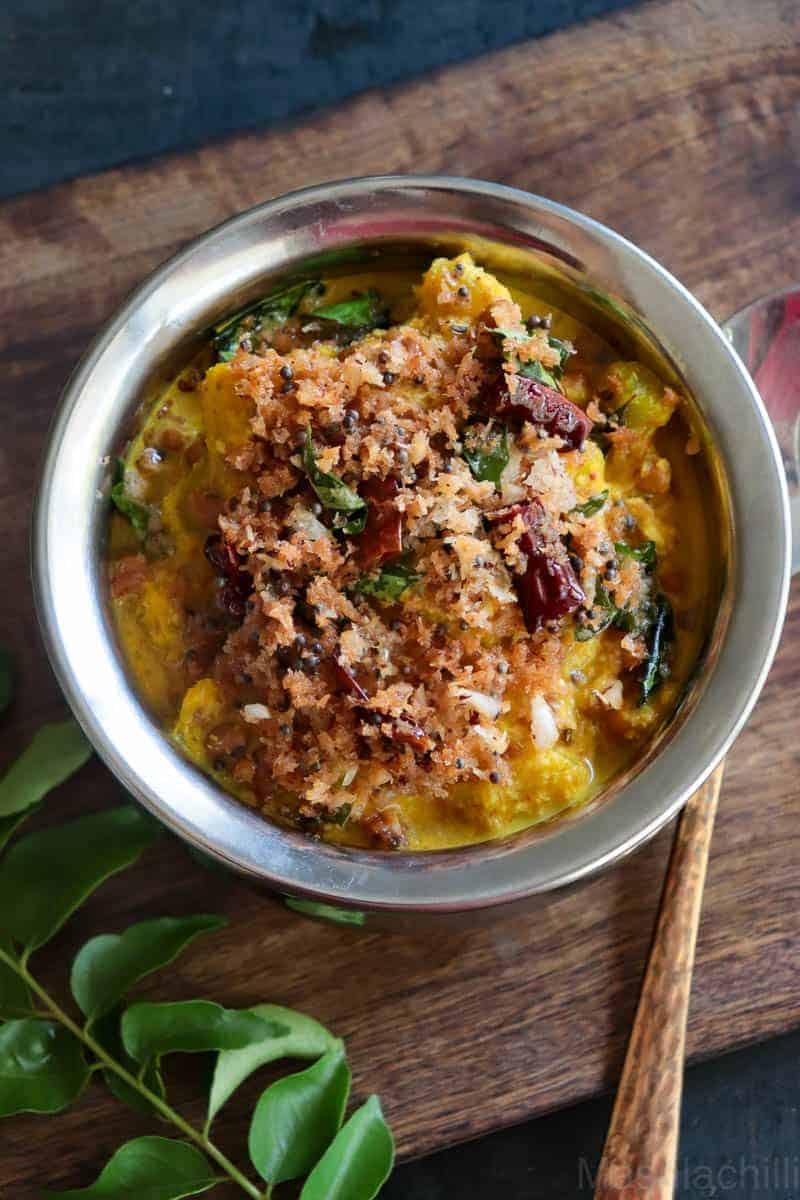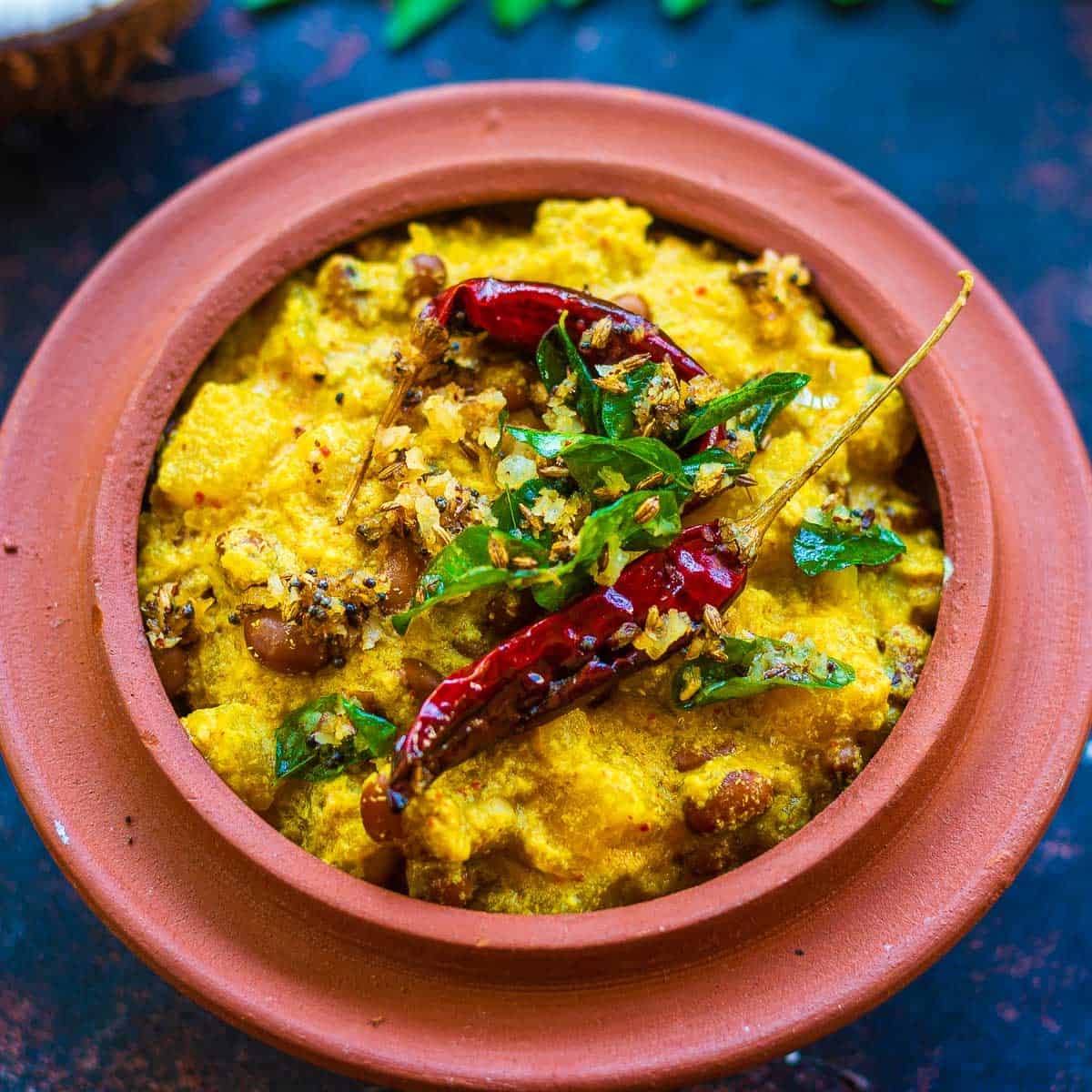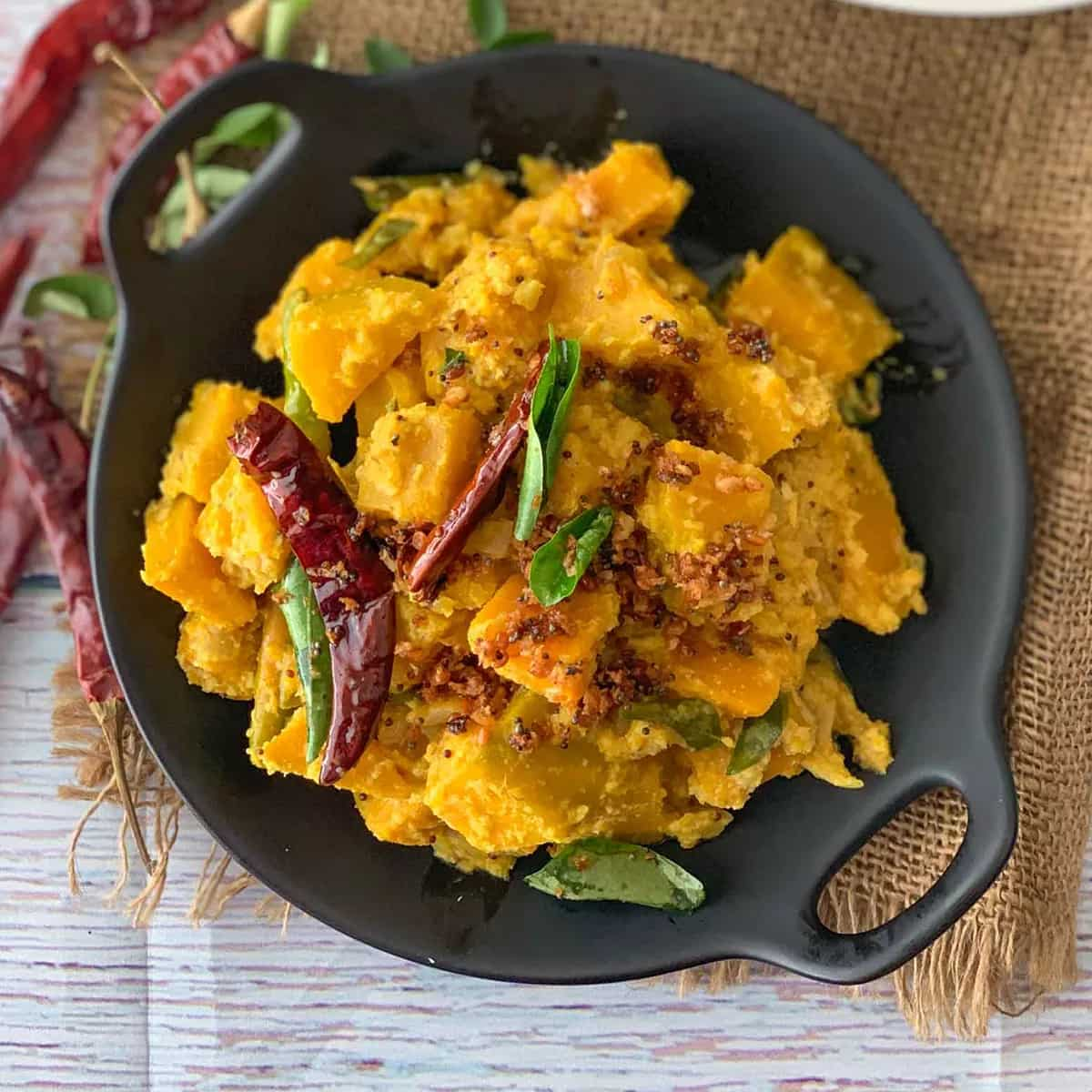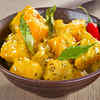Erissery is a cherished dish from the South Indian state of Kerala and is a staple in traditional Keralite cuisine. This aromatic and flavorsome curry contains a harmonious blend of vegetables and legumes with coconut being a star ingredient. The most common versions include pumpkin Erissery, made with yellow pumpkin (mathanga), and the banana Erissery, utilizing raw bananas or plantains.
These vegetables are cooked with soaked and boiled beans such as red cowpeas (vanpayar) or black-eyed peas until they are soft and tender. The standout feature of Erissery is the ground coconut paste, which imparts a rich and creamy texture and is flavored with green chilies, cumin, and sometimes garlic. This paste is then mixed into the cooked vegetables and legumes.
Erissery Recipe


Erissery
Equipment
- 1 medium pot
- 1 small skillet
Ingredients
- 2 cups cubed plantain
- 1 cup cubed yam
- 1 cup water
- 1/2 teaspoon ground turmeric
- 1 teaspoon salt
- 1/2 cup shredded fresh coconut or frozen, thawed to room temperature
- 1 tablespoon peppercorns
- 1/4 teaspoon cumin seeds
- 1 tablespoon coconut oil
- 1 teaspoon mustard seeds
- 2 curry leaf sprigs
Instructions
- In a medium pot over medium-high heat, combine the plantain, yam, water, turmeric, and salt. Cover the pot and cook for 8 to 10 minutes until the vegetables are soft and tender.
- While the vegetables cook, in a blender, combine the coconut, peppercorns, and cumin seeds and grind into a coarse paste.
- When the vegetables are soft and tender, add the coconut-spice paste and mix well. Cook for 5 minutes and turn off the heat.
- In a small skillet over medium heat, heat the oil.
- Add the mustard seeds and curry leaves and cook until the mustard seeds begin to sputter, about 1 minute. Turn off the heat. Stir this spice mixture into the vegetables until mixed well.
Notes
vegetables and plantain and add 1 cup cooked black-eyed peas.
Cooking Tips about Erissery

- Select the right vegetables: Traditionally, pumpkin (mathanga) or raw bananas (plantains) are used in Erissery. Choose ripe but firm pumpkins or green plantains for the best texture.
- Properly prepare legumes: Soak the beans, such as red cowpeas (vanpayar) or black-eyed peas, overnight or for at least 6-8 hours to expedite cooking and make them easier to digest.
- Cook legumes until tender: Ensure that your legumes are cooked through but not mushy, as they need to hold their shape within the dish.
- Grind coconut paste to a fine consistency: The coconut paste, which includes grated coconut, cumin seeds, green chilies, and sometimes garlic, should be ground finely to create a creamy and rich base for the curry.
- Balance flavors: Adjust the amount of green chilies according to your spice tolerance. The sweetness of the pumpkin or the starchy taste of the plantains should complement the spice without overpowering it.
- Don’t overcook the vegetables: Vegetables should be cooked just right — they should be soft enough to be mashed slightly but should retain some texture to add body to the dish.
- Perfect the tempering: The tempering, known as tadka, is crucial. Heat oil or ghee, splutter mustard seeds, fry dry red chilies and curry leaves till aromatic, and roast grated coconut until golden brown before adding it to the Erissery.
- Mash vegetables lightly: Once the vegetables and legumes are cooked, gently mash them to thicken the curry, ensuring that some pieces remain whole for texture.
- Consistency matters: Erissery should be thick with a pourable consistency; it is not a watery curry. If it’s too thick, you can add a little warm water; if too thin, cook it down a bit longer.
- Finish with a drizzle of coconut oil: For an authentic flavor, drizzle a teaspoon of coconut oil over the finished dish and cover it for a few minutes before serving.
Serving suggestions about Erissery

- With Steamed Rice: The most traditional way to serve Erissery is alongside steamed rice. The creamy texture of the curry complements the softness of the rice perfectly.
- Part of a Sadhya Meal: Include Erissery as part of a Sadhya, the Keralite feast during festivals such as Onam or Vishu. This allows the curry to be enjoyed with a variety of other dishes.
- With Indian Breads: Serve it with Indian bread like Malabar Parotta or Appams for a slightly non-traditional yet delicious pairing.
- Topped with Ghee: A spoonful of ghee drizzled on top of the Erissery right before serving can add a rich aroma and enhance the flavors.
- Alongside Pickles and Papadums: Complement the curry with spicy Indian pickles (achar) and crispy papadums for added texture and taste.
- Raita or Yogurt: A side of raita or plain yogurt can balance the earthy flavors of Erissery with a touch of coolness and mildness.
- Garnish with Fried Shallots: Sprinkle fried shallots on top for a savory crunch that contrasts the creaminess of the dish.
- Serve with Vegetable Thoran: Accompany the curry with a Kerala-style stir-fried vegetable dish known as ‘thoran’ for a nutritious and fiber-rich meal.
- Kachumber Salad: Offer a simple salad like Kachumber, made with cucumber, tomato, onions, and lime juice, which provides a refreshing side.
- With Mango Chutney: A sweet and tangy mango chutney can act as a delightful accompaniment, mirroring the sweetness present in many versions of Erissery.
Top 5 FAQs about Erissery

- What type of beans are used in Erissery? The most commonly used beans for Erissery are red cowpeas (vanpayar) or black-eyed peas. These legumes are soaked, boiled, and then cooked with the vegetables to lend a hearty texture to the dish.
- Can Erissery be made without coconut? Coconut is a fundamental ingredient in Erissery that imparts its characteristic rich flavor and creamy texture. While modifications can always be made, omitting coconut would significantly change the authentic taste of the dish. Instead, one could try using coconut milk as an alternative if grated coconut isn’t available.
- Is Erissery a spicy dish? Traditionally, Erissery is mildly spiced with green chilies, cumin, and the tadka made with mustard seeds, dry red chilies, and curry leaves. The spice levels can be adjusted based on personal preference, but it is not generally considered a highly spicy dish.
- How long can Erissery be stored? Erissery can be refrigerated for up to 2-3 days in an airtight container. When reheating, you may need to add a bit of water as it tends to thicken over time. Freezing is also possible but may alter the texture due to the coconut content.
- Is Erissery suitable for a vegan diet? Yes, Erissery is naturally vegan-friendly as it is made using vegetables, legumes, and spices without any animal-derived ingredients. However, one should ensure that it is not finished with ghee (clarified butter) which is sometimes used in traditional Indian dishes.
Erissery is not just a dish; it’s a celebration of culture, traditions, and the culinary richness of Kerala. This wholesome, nutrient-packed curry embodies the essence of Keralite cuisine, bringing together the sweetness of vegetables like pumpkin or plantains with the earthiness of beans, all unified by the rich, creamy texture of the ground coconut paste. The tempering, or tadka, further elevates Erissery with its aromatic splendor, providing a nutty crunch that delights the senses.

Leave a Reply